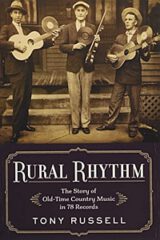The label “Old-Time Music” refers to American-made music, instrumental and with vocals, that was performed nationwide in public and privately from roughly the early 1800s until the early 1940s, although it became mostly a regional style in the early 20th century.
 Those (basically all white) musical groups usually featured string instruments such as mandolins, banjos, fiddles, and guitars. However, as recording scouts and mobile studios since the 1920s had their focus on the South, the Midwest and Southwest, the music of those parts is documented best, even though there was much more talent around. String instruments, due to their easy transport and relative cheapness, were very popular in the pre-radio days, additionally, there were musicians in almost all rural families.
Those (basically all white) musical groups usually featured string instruments such as mandolins, banjos, fiddles, and guitars. However, as recording scouts and mobile studios since the 1920s had their focus on the South, the Midwest and Southwest, the music of those parts is documented best, even though there was much more talent around. String instruments, due to their easy transport and relative cheapness, were very popular in the pre-radio days, additionally, there were musicians in almost all rural families.
As early as 1913, summits and contests were held to find the best fiddler; other string instrument contests happened even earlier. Considering the versatility and skills of many of the documented bands, it is very likely that today, with modern ways of recording and distributing music, probably several of them would be superstars.
Today’s musical styles such as country music, bluegrass and Americana are a direct result of that Old-Time Music (or in this case Old-Time Country Music) and its respective protagonists.
In the 1910s and 1920s one media for distribution was most popular, even though it cracked easily, namely the shellac 10” record, it used a playback device that ran at a speed of 78 rpm. This number explains Russell’s book title, where he concentrates on 78 individual shellacs that provide a good overview of the various kinds of Old-Time recordings and their respective histories. On an average of 4 or 5 pages, Russell’s short texts on the discs usually deal with the genesis of the song, the studio situation, lineup, technical staff and variations of the lyrics or setup. He also comments on speed, rhythms, special arrangements or novelties of the recording sessions.
“The title has a double meaning. ‘Rural rhythm’ – which, lexically, at least, is almost a synonym for ‘country music’ – suggests the tempos and styles of rural and small-town music-making hints at the gearshift that accelerated country music from the barn-dance pace of the 1920s to the hyperdrive of late ‘30s proto-bluegrass and Western Swing.”
Furthermore, for each recording there is elaborate introduction on how historical content, individual stories, tragedies or political decisions, laws or taxes influenced the lyrics and how a fraction of rural life was represented in the tune.
The arrangement is chronological, the selection, however, is very personal and not arranged by sales or popular success. “Sales figures survive for some (unfortunately not all) of these recordings, and are duly provided, but this is not a catalog of old-time-best-sellers. Nor is it confined to what are customarily considered historically important recordings … Several of the records discussed here were huge hits, wayside markers on the long road of sociopolitical history. Others sold in only moderate quantities, some in mere hundreds … Why write about them, then … ? Because their obscurity is very often unmerited, and besides, they contain what I believe to be valuable information about the period and milieu, information that has not always found a place in the official narratives of American social history. … The recordings … are messages from another time and sometimes reach us in code. To understand them, we must decipher them, which in many cases is what this book tries to do.”
The songs introduced include the initial country song ever recorded, namely “The Little Old Log Cabin in the Lane” by Fiddlin’ John Carson (1923) and the first two takes of an Old-Time music group, “Silly Bill” and “Old Time Cinda” by the Hill Billies (1925). The list then continues with “Guitar Blues,” “Sweet Hawaiian Chimes,” “Truck Driver’s Blues,” “Over the Hills to the Poorhouse” and “Haunted Hunter” among others. The final shellac is “New San Antonio Rose” by Bob Wills and His Texas Playboys (1940), a tune that sold millions of copies and has been covered by hundreds of bands over the decades.
Rural Rhythm is an excellent title, hard to imagine there could be a better book on those 78 pieces, but after all, English music historian Russell, over the decades (!) made a name for himself with his previous works on jazz, blues, and country music. Additionally, he founded the journal Old Time Music twenty years ago and has published widely in the Guardian, MOJO and has been a consultant for many music documentaries featuring American music and its artists.
The title is fueled by Russell’s routine and skills in combining brief but adequate background information with quotes, Billboard histories, the facts of life in rural parts of the US, and the cultural standing and development of county music and its predecessors. It comes lavishly illustrated with hundreds of black/white promotional pictures, label reproductions, studio and stage shots, a concise phonographic-raidiophonic-sociohistorical timeline and song index.
Review by Dr. A. Ebert © 2022
Tony Russell. Rural Rhythm: The Story of Old-Time Country Music in 78 Records. Oxford University Press, 2021, 315 p.
